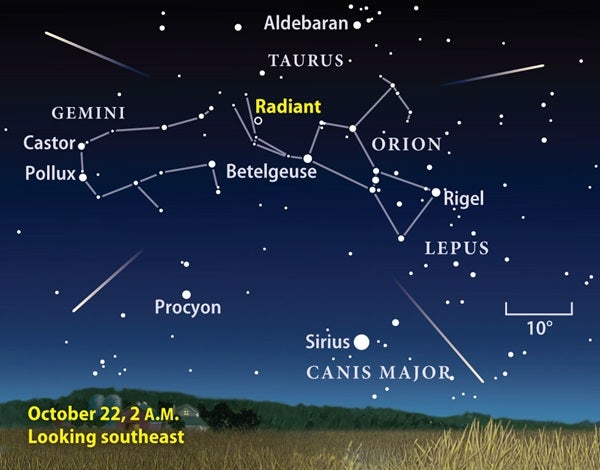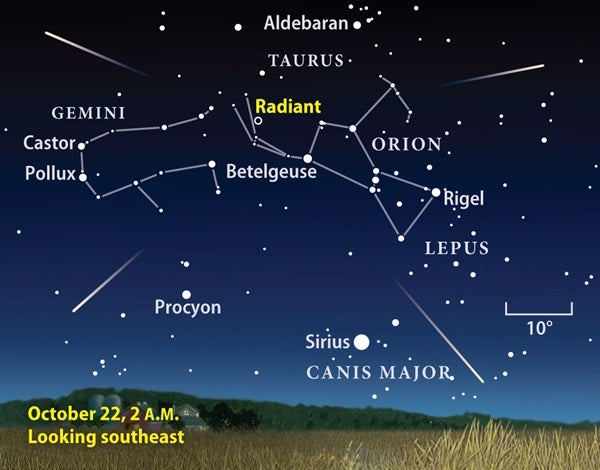One of the year’s better meteor showers makes its appearance this coming week. The Orionid shower peaks the night of October 21/22, with the best views coming before dawn on the 22nd. In a good year, observers can expect to see 20 to 30 “shooting stars” per hour — an average of one every 2 to 3 minutes — at the Orionids’ peak.
According to Astronomy magazine senior editor Michael E. Bakich, conditions should be good this year: “Although a waning crescent Moon will share the sky with the Orionids, it will be more of a nuisance than a problem. It shouldn’t cut the number of visible meteors by more than 20 percent. If it bothers you, just face away from it.”
Orionid meteors began life as tiny specks of dust ejected by Comet 1P/Halley during its innumerable trips around the Sun. Over the eons, these particles spread out along the comet’s orbit. Every October, we run into this stream of dust.
The particles hit Earth’s atmosphere at 148,000 mph (238,000 km/h), vaporizing from friction with the air and leaving behind the streaks of light we call meteors. The meteors appear to emanate from the northeastern part of the constellation Orion the Hunter (hence their name), near its border with Gemini.
The best views will come in the hours before dawn starts to paint the sky, between about 2 a.m. and 5 a.m. local time. The shower’s radiant then lies higher in the sky, which means fewer meteors will disappear below the horizon.
Just as important, observers lie on Earth’s leading hemisphere in the hours after midnight. “Think of what happens when you drive through rain or snow — more precipitation pelts the front windshield than the rear,” says Bakich. In the same way, Earth runs head-on into the dust stream after midnight and sweeps up more of the tiny dust particles.
If the weather looks iffy the morning of October 22, try viewing the morning before or after. The Orionid shower often produces a nearly steady stream of meteors for several consecutive nights.
Fast facts:
At 148,000 mph (238,000 km/h), Orionid meteors are the second-fastest of any annual shower. Only the Leonids of November hit our atmosphere faster, at 159,000 mph (256,000 km/h).
The Orionid meteor shower is one of two that derive from Comet Halley’s debris. The other is the Eta Aquarid shower, which peaks in May.
- Video: How to observe meteor showers, with Michael E. Bakich, senior editor
- Video: Easy-to-find objects in the 2011 autumn sky, with Michael E. Bakich, senior editor
- StarDome: Locate the constellation Orion the Hunter your night sky before this meteor shower with our interactive star chart.
- Sign up for our free weekly e-mail newsletter.












